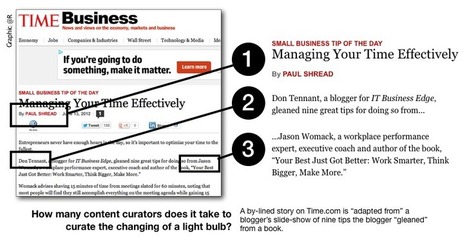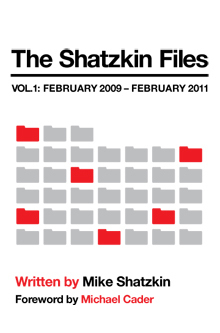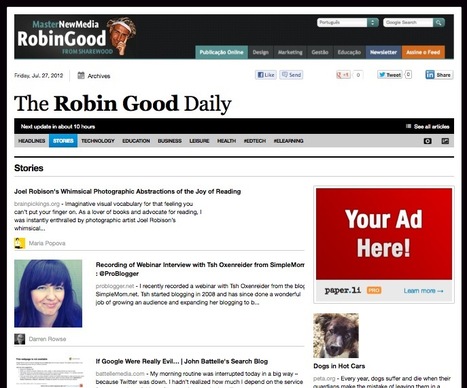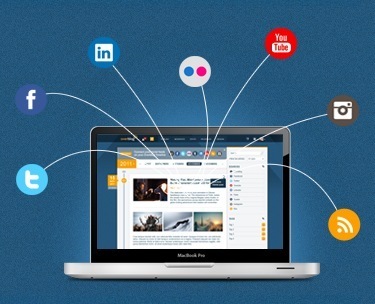 Your new post is loading...
 Your new post is loading...
Robin Good: Good article by Rex Hammock on RexBlog.com highlighting the confusion arising from using the term curation when it is not really appropriate. He writes: "Somewhere along the way, the inherently-confusing metaphor of curation being applied to content on the web went from something like, finding relevant content and pointing readers to it to something like, find content on other sites and simply re-write what they say and place it on our site and that’s okay, as long as somewhere you credit the source.” He has several more interesting points. here a few key excerpts from it: "While I believe “curation media” can be a helpful service to readers, the act of writing a story that rehashes another story — without adding some insight or background — is a disservice to all involved. ... "...I’m not suggesting that the act of sharing articles you run across is anything but good. I’m not even suggesting that websites like Huffington Post or Business Insider are nothing more than re-writing services. (I’m not “suggesting” it, as it’s well known.) This is the bottom line: To be of any value (or to prevent you from appearing foolish), your curation needs to be more than merely re-writing something that has already been re-written one or two times. If you feel the need to do that, just link." Rightful. 7/10 Full article: http://www.rexblog.com/2012/06/14/47898 ;
Via Robin Good
This is a Mike Shatzkin article published in 2009 that I discovered through Robin Good.
"Every time I read a story about why newspapers are failing that doesn’t mention the role of aggregation and curation in their troubles, it reminds me that something very fundamental is being missed, even by very sophisticated observers." he starts.
Having been an actor of the digital disruption in the music business, the comparison of publishing with the music industry (and subsequently of the newspaper with the 12/15 song album) is dear to my heart.
The Music Industry lost a lot of time and effort blaming piracy while not realizing albums had stopped making sense and that they had opportunities around curating playlists or compilations that they didn't exploit.
Likewise, the opportunity to create new relevant media through curation has never been that big.
by Guillaume Decugis
Via Robin Good, Guillaume Decugis
Robin Good curated this piece and has some very interesting observations in addition the article. Mathew Ingram makes a great point in this post I discovered thanks to Morten Myrstad: one way for Media groups to re-invent themselves is to think of themselves as data platforms and not newspapers any more. Great point. But I see one more: opening up to other news platforms too even if competing. I appreciate this clearly faces cultural resistance but if you think of it really as a platform, you shouldn't be afraid to interface it with your competitors' just like Twitter has a LinkedIn App. One missed opportunity I see that reflects this is the WSJ Facebook App: it's a great concept to let your readers remix the headlines but why not do it with non-WSJ content too? I'd love to see through a crowd sourced effort from the most WSJ active readers and curators how some WSJ-news relate to other news from say the FT or the Economist. I’m going to make my music-industry analogy again (can’t escape my background…) but right now media groups think of building a record store or a radio station with their own artists. Imagine a radio that would play only Universal Music Group artists? It would suck, right? Yet, that’s what most media are today. Don't you think the industry needs bold moves like this?
Via The New Company, Guillaume Decugis, Robin Good, janlgordon
This post was written by Tony Karrer from Aggregage He has some interesting things to say about an article he read by Ville Kilkku, which was all about the future of content curation, the title of the piece he's referring to in this post is "Klout, Triberr, paper.li, and the future of content curation". Intro He says,
"Reading this article made me realize that people curation should be a lot of what we are really talking about here. But before I get to that, let me step through what he talks about. He takes us through a few different models of content curation. I’m going to need to compare these to my post on Marketing via Aggregation, Filtering and Curation – Tools and Resources to see if this classification changes things."
He then talks about three major trends in content curation: From individual content curators to crowdsourced content curation: Individuals cannot keep up with the pace of new content, even though they have better discovery tools than before. Crowdsourcing can, although it is not suitable for promoting radical new ideas: the dictatorship of the masses is unavoidably conservative. From manual to semi-automated content curation: Individual content curators are forced to automate as much of the process as possible in order to stay relevant. From content curation to people curation: When there is too much content, you vet the content creators, manually or automatically. Those who pass get exposure for all of their content. What caught my attention: How do these trends interact? Social networking of the content creator is vitally important in order to create an audience as isolated content becomes increasingly difficult to discover and curation focuses on people instead of individual content. Build it, and they will come, is dead. http://www.aggregage.com/blog/curation/people-curation
Via janlgordon
Urbanspoon has signed a deal with Zagat that will see over 25,000 Zagat reviews featured prominently on Urbanspoon. Urbanspoon has signed a deal with Zagat that will see over 25,000 Zagat reviews featured prominently on Urbanspoon. Urbanspoon tells WebProNews, “”We’re excited to be working with Zagat – the pinnacle of high end restaurant reviews. Providing diners with easy access to Zagat reviews directly on their smartphones will make it even easier to select the best dining options.” “Our goal at Urbanspoon is to give users the most accurate, in-depth look at local restaurants to help inform their decision about what new spots to try and which favorites to keep on their go-to list,” said Urbanspoon GM Kara Nortman. “Bringing in content from Zagat, arguably the most famous name in restaurant reviews, adds another layer of trusted insight to help people find the best restaurants in their cities.” Zagat’s ratings and recommendations for restaurants will appear alongside Urbanspoon’s aggregated content. Users will be able to access the reviews along with general business info, photos and related blog posts. This is the whole piece, there's a visual to show you how it'll look when you click here and scroll to the bottom. http://www.scoop.it/t/content-curation-social-media/p/418629223/curation-at-it-s-best-urbanspoon-adds-zagat-reviews
Via janlgordon
|
Robin Good: Paper.li one of the early players in the news aggregation, discovery and auto-curation space has been significantly improving its service which now offers also a $9/month Pro version. Paper.li allows you to set a number of search queries on Twitter, Facebook, Google+, YouTube and to import specific RSS feeds to "aggregate" the most relevant on a certain topic or theme. You as a curator can "preview" your yet-to-be-published news magazine and can manually pick and decide which "stories" to publish and which ones to drop by simply hovering your mouse on anyone of them. "Editions" can be auto-scheduled and Paper.li can automatically announce on Twitter and via email to your subscribers when a new one is out. PRO users get to have the last word before any edition gets published, by way of a "preview before promotion" feature that lets you control when notifications go out and gives you time to make changes, can add promotional banners, standard ads or other marketing materials in a set of predefined hot spots on their news page, and can "brand" their magazine with their own banner, background image and personalized colors. More info: https://paper.li/learn-more.html Try it out now: https://paper.li/
Via Robin Good, Tim Pixley
Robin Good: Overblog is a new web service which allows anyone to create a website automatically built around the content you are already posting and sharing on your favorite social media channels. In addition you can also post directly via Overblog any kind of content by using a modular, add-the-content-type you want into unique, rich media posts.
Overblog also provides the ability to video-live stream on your site straight from your mobile phone as well as over 100 of nicely pre-designed and fully customizable templates that can be utilized to personalize your "social media blog".
Analytics for traffic stats are included as well as the opportunity to monetize your "social media blog" by optin-in for it.
It is also possible to launch as many blogs as you want with a single ID and to grant access to as many contributors as you want (and to define what you want to give them permission to do: write, review, or post.)
N.B.: Your newly created "social media blog" works and can be seen properly across all kind of devices, from desktop to mobile. Here is a simple test I have run on it: http://robingood.overblog.com/ ; Free to use. Find out more: http://en.over-blog.com/ ;
Via Robin Good
I really liked this article by Romain Goday from Darwin Ecosystem about content discovery tools and particularly the way he described the element of the "human touch" and why they go hand and hand. His description of the human part of the equation eloquently describes the process of a content curation. Intro: Content discovery tools have been trending towards taking over an increasing part of the selection process by filtering out information. Content Selection Should Remain a Vital Part of the User Experience Excerpt: While tools carry the advantage of computing and aggregating information quickly on the user’s behalf, the user possesses a number of natural skills that tools cannot adequately take the place of. Here are a few of the most important ones, as they relate to selecting and identifying relevant content: Users are contextual thinkers: The relevance of a piece of information depends highly on the context of the informational need. The motivation and goal of the user determines what information is important and what information is not. Users possess relevant expertise: The user’s expertise helps them to predict the implications of a particular event. It also allows the user to identify anomalies that take place in the usual development of an event based on their experience with the topic. Users make sense of patterns: The human brain can easily understand the relationships between multiple events. This ability to interpret patterns is critical to understand and identify what is going on and how it’s developing. Curated by JanLGordon covering "Content Curation, Social Media & Beyond" Read full article: [http://bit.ly/sUQxGs]
Via janlgordon, catspyjamasnz
This article was written by Marshall Kirkpatrick for ReadWriteWeb You make data. A lot of it. From Web browsing to link sharing to photos published online, from phone bills to medical records to online banking - almost all of us produce an incredible amount of electronic data that slips right through our fingers... Here's What Went Live 10/19 In case you didn't see it: Very exciting! Singly 1.0 began rolling out to developers Oct. 19, 2011 ****Those first users will be able to build apps that search, sort and visualize contacts, links and photos that have been published by their own accounts on various social networks but also by all the accounts they are subscribed to there. ****Want to search the contents of every link shared by every person you're subscribed to on Twitter (at least as far back as Singly can access)? ****Want to make a slideshow of all the Instagram photos your contacts have posted that have a certain hashtag in them? Or were on a weekend? Or whatever other criteria you can think of? Those kinds of things are possible now. http://www.readwriteweb.com/archives/singly_platform_launch.php Curated by JanLGordon covering "Content Curation, Social Media & Beyond"
Via janlgordon
Absolutely fascinating! Intro: In 2008 the number of devices connected to the Internet surpassed the number of people connected, and in 2020 there will be 50 billion things connected, 7 times the world’s population, according to Dave Evans of Cisco. The infographic below highlights some of the key features of the Internet of things, including the pace of growth, how external data can be aggregated so that your alarm clocks, cars, and coffee makers make decisions to fit with your schedule, and that some cameras and computers are now just a cubic millimeter. An amazing statistic is that by end of 2011, 20 typical households will generate more Internet traffic than the entire Internet in 2008. That is slightly unbelievable, and I would like to know how they define ‘typical’ and what data is generated for Internet communication. However it is important to recognize that the Internet of things is one of the most important ways to understand our connected future. Pervasive connectivity, and the amazing things we will be able to do with that, will shape our lives. http://rossdawsonblog.com/weblog/archives/2011/09/the-internet-of-things-will-dwarf-the-internet-of-people.html
Via janlgordon
I just ran across this post from August 10th, I didn't see this before and maybe some of you didn't. The new personalization layer in News360 is still automated, but it harnesses the user's own human qualities. Here's an intro: "News360, a news reader app available on most mobile devices and tablets, has just announced version 2.0, which adds a layer of personalization to the news shown to each user, whereas it was just an aggregator before." News360, a news reader app available on most mobile devices and tablets, has just announced version 2.0, which adds a layer of personalization to the news shown to each user, whereas it was just an aggregator before. The update also launches a beta Web version of the service, so you can use it on the desktop. Finally, the new version adds a timeline view, which allows you to track a story's development over time. When News360 launched, it simply pulled in coverage of stories from multiple sources, like Google News does, as well as Twitter discussions of the topic. It offered a few ways for users to go more in-depth, with image galleries, great definitions of terms and the ability to manually add more personalized feeds by topic. It certainly provided more content than a human-curated service, like Newsy, but it lacked that human quality of editorial discernment. The new personalization layer in News360 is still automated, but it harnesses the user's own human qualities. http://www.readwriteweb.com/archives/news360_20_personalizes_news_aggregation.php
Via janlgordon
|
 Your new post is loading...
Your new post is loading...
 Your new post is loading...
Your new post is loading...




























See my Brickflow example here:
http://rbauerpt.blogspot.com/2013/08/start-lean-fitness.html